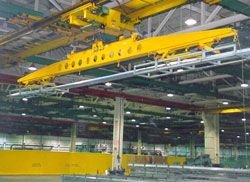Got a gantry or overhead crane? Let’s review three small steps that can help reduce risk to personnel and the cranes.
1) Paint a continuous stripe on the floor (likely forming a rectangle) that represents the maximum trolley and travel distance of the crane hook. You can hang a plumb bob from the hook and by starting with the crane in the extreme northwest corner of its trolley and travel point, travel due south marking the floor with a permanent marker. After arriving in the southwest corner, now trolley the crane to its extreme east trolley point and mark the floor every few feet. Repeat the process while moving north and then west, marking the entire perimeter travel range of the crane. Paint a 4” wide continuous stripe on the floor over the marks with a wide brush using bright safety color paint.
You have now established the maximum operating zone for the crane. Anytime a load is forklifted into the crane bay, ensure that the load’s center-of-gravity is within the established operating zone. The painted rectangle also alerts employees who must rig and handling machinery and components in the crane bay as to the available “reach” of the overhead crane. This can prevent side-loading the crane which can cause hoist rope damage (a dropped load and injured personnel), or undue mechanical stresses on drive shafts and bearings.
2) If adjacent doors and hallways enter a crane bay, place flashing yellow lights near their door frame or archway entrance points. Inside the crane bay, mount a motion sensor pointing up at the ceiling that covers a 30’ wide span that can detect the crane bridge or trolley hoist movements. A crane in operation that enters the motioned detected zone will cause the sensor to activate the flashing light. The light is a pre-warning to those about to enter the crane bay that the crane is operating in the immediate area. Extreme caution should be exercised and approval given to enter through that specific passageway.
3) When the crane is not in use, move the hoist block at least high enough to avoid vehicular (forklift) traffic, in a designated “parking zone”. The pendant control (if applicable) should be bungee-chorded to an anchor point so it doesn’t drift uncontrollably under the bridge.
For more tips about crane handling information, check out “Operating Practices” in ASME B30.2 or visit the Crane Manufacturer’s Association of America and the Material Handling Institute of America (CMAA/MHIA) website at www.MHIA.org. Furthermore, ITI has been conducting Overhead Crane Operator Training for over 30 years.
Happy trails to my crane and rigging friends,
Mike Parnell
President, ITI-Field Services




COMMENTS